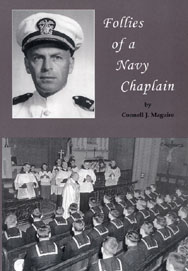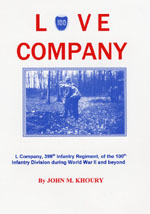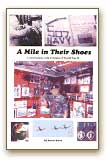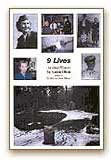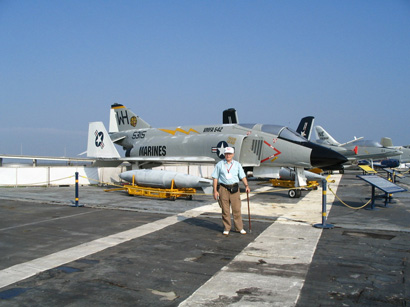©2005,2009 Bruno Ehlich
Chapter 5
Last Days of the War, 1945
In late April the strength of the German military in Leuchtenberg was nearly doubled. Mostly infantry, SS and Gestapo; especially around the Castle, which was heavily guarded. We did notice a lot of trucks entering and leaving which brought in many prisoners from the concentration camp. These prisoners started digging trenches around Leuchtenberg and then we knew that we were preparing for the battle of Leuchtenberg, sooner or later.
One day Mum and my brother were sitting around our kitchen table having our lunch. It was comprised of potato soup and bread which we received from one elderly kind German infantry cook. We heard this strange "wobble wobble" noise approaching. Little did we know but death was just about to miss us by 25 meters. The flash accompanied by this tremendous bang and following concussion completely ripped our window out of the wall and the air pressure lifted my mother, brother and me out of the chairs and threw us against our kitchen door. The table landed on top of us and the window and hundreds of glass shards and splinters landed on top of the table.
Life stopped for many seconds. I did not realize what had happened until Mum, who was covered in a potato soup and glass mixture, dragged my brother and me out of the rubble. Mum did not say anything; she was pale and shaking. Then we heard the siren going off and we stormed downstairs out into the open. Mum was immediately led away by the Red Cross sisters and my brother was taken to the military hospital next door. However, little me at nine years old, was given a metal bucket to join the bucket brigade to extinguish the fire that raged through the roof of the Gestapo headquarters.
So, why did that shell hit the Gestapo HQ and burn the roof out but do little other damage except to have nearly killed my family and me? First, the U.S. must have had a very good intelligence system and second, an excellent marksman to hit that building in the middle of the village without doing much damage to anything else. My answer is that they knew that the Castle was stuffed from top to bottom with all the confiscated goods and artifacts from the murdered inmates and locked up victims from those nearby concentration camps. These goods included fine art, paintings, silver, jewelry, gold, diamonds, porcelain items, fine gold and silver cutlery, etc. Even today Germany is searching for all of those lost and stolen items. Many will never be found as they were mostly buried in caves, mines or sunk in the depths of lakes and rivers. Some of the goods were shipped out and hidden in foreign countries.
The American forces must have obtained this information and therefore did refrain from bombing or shelling the castle. The castle had a very fine observation tower. It had hundreds of German troops stationed there. Why was the village only hit once during the war? The Americans must have known about that booty. Someone must have told them, perhaps an escaped prisoner or a German with a guilty conscience.
During my stint in the Castle, I saw dozens of trucks being unloaded and later, in the last days, being loaded again. God only knows where all this booty was shipped. After the war ended, rumor was that lots of gold jewelry was deep down in the castle. Well, it could have been. Many times we boys looked down into the well only to see the murky waters and lots of military junk floating around -- mostly discarded uniforms, caps, etc. God only knows what was underneath this slime.
But back to our burning Gestapo HQ. By the direction from which this artillery or tank shell came, we knew that it was only a matter of days before the Americans would storm Leuchtenberg. School had now been suspended and we boys from the age of eight to 16 years had to help the army. The fun was over. I was detailed to run telegraphic wires up into the castle tower where the army installed an artillery command post. I also had to observe the military advances of the U.S. Army, now only kilometers away. It may seem strange but 50 years later, my American friend Vern Schmidt told me that they were seeing us from the town of Vohenstraus, 10 kilometers away. I was right after all. The U.S. Army was only kilometers away.
Later in April, we had to help in running telephone wires into the trenches. My brother was standing in a trench, leaning against a skinny tree. He was only six and a half years old. He took a dive into the trench as a bullet carved a neat one-inch hole two inches above his head and into that skinny tree trunk. Today, 50 years later, I can still hear the sickly ssshippp as the bullet hit. Well, my brother and I took off. We ran the one kilometer up to the village absolutely flat out. My brother nearly passed out with his asthma as we ran up to the army headquarters to report the incident.
By now, the SS had seen the American GIs advancing up the slopes but to my amazement they packed up and started to vacate the village. Now the last remaining SS troops commanded three of us boys and a 20-year-old soldier to man this small anti-tank gun. This was called by the Germans the "Door Knocker" as the small projectiles mostly glanced off the heavy tank armor while scarcely scratching the hull.
We boys and our soldier placed this small artillery piece about 100 meters from the bridge across the River Luhe, then hid amongst the pine trees. My job was to bring the requested shell from the ammunition dump 20 meters from the gun to the loader posted at the gun. The ammunition itself was in wooden cases and every case had different shells in them. There were shells with those glassy looking green tips, red tips and yellow tips. I was told never ever to drop one of them onto that glass tip as the resulting explosion would have killed most of us.
Anyhow, we heard a rumbling noise coming from around the bend and then the first Sherman tank was approaching the bridge. Why in God Almighty did they attempt to cross that bridge without first checking for mines or explosives? No, they were coming right for it.
Our gun commander had this tank in his sights. He was cursing the gun; he was elevating the barrel and then he commanded "Loading!" The shell went into the breach. By then my nine year old heart was pounding as I was watching this, as if in slow motion, from 20 meters away. "FIRE!" yelled the young commander. The shell left the barrel and seconds later hit the Sherman tank. The shell glanced off the tank and exploded into an enormous ball of fire and smoke near the tank. All I remember is our commander yelling for a yellow tip shell and next I was airborne. I never heard the bang. All I remember was hitting a tree and then rolling into a bush meters away from where I had been.
Standing up in agony I noticed our gun upside down and all four crew amongst the wreckage. The Sherman was now about 50 meters away with the turret open and I could see the gunner in the turret. As there was no movement in the bodies, I took off, racing up towards the Castle. I knew that no tank could chase me up this hill as it was covered with meter-high granite rocks and was very, very steep.
On reaching the top and nearing the Castle, especially around the Nazi HQ, I could see they were packing up. The remaining SS and army troops were racing around, loading up their gear and weapons. I was told by one Nazi official to make my way up to the Castle tower and to start rolling up the wires. All of a sudden the troops started burning their uniforms and destroying official documents in the middle of town. How funny this seemed to me.
Now, hardly any village people were to be seen and under orders I ran up towards the Castle, and through the Castle gate. Up there, I was nearly run over by a large German army truck loaded to the hilt with stolen goods. Not knowing what I should actually do, I raced up into the tower. Not a German soldier was to be seen. Then the bullets and shells started zipping around amongst the castle walls. I hid under some heavy crates. Standing there, I decided to run back into the village. I ran through the castle gate and that was when I was hit in my right arm. My arm dangling and blood spurting, I noticed a metal object sticking out of my lower arm. Running out of the castle I was followed by some GIs who were coming over the walls like monkeys. How I never got killed puzzles me even today but being so small and frail and only nine years old, I must have been spared by the GIs. Then, as I rounded the corner near the church, into the main road, I ran directly into a huge GI from the 90th Division. He lifted me up and I stared into his painted face. He had me by the throat and yelled, "Where are all the village people, BOY?" The war was over for me, I had survived -- a nine year old boy with one wounded arm. Lucky! Most of my friends gone, killed for what? For some hilarious little comic called Hitler. However, this is life, "born on the wrong side of the fence."


